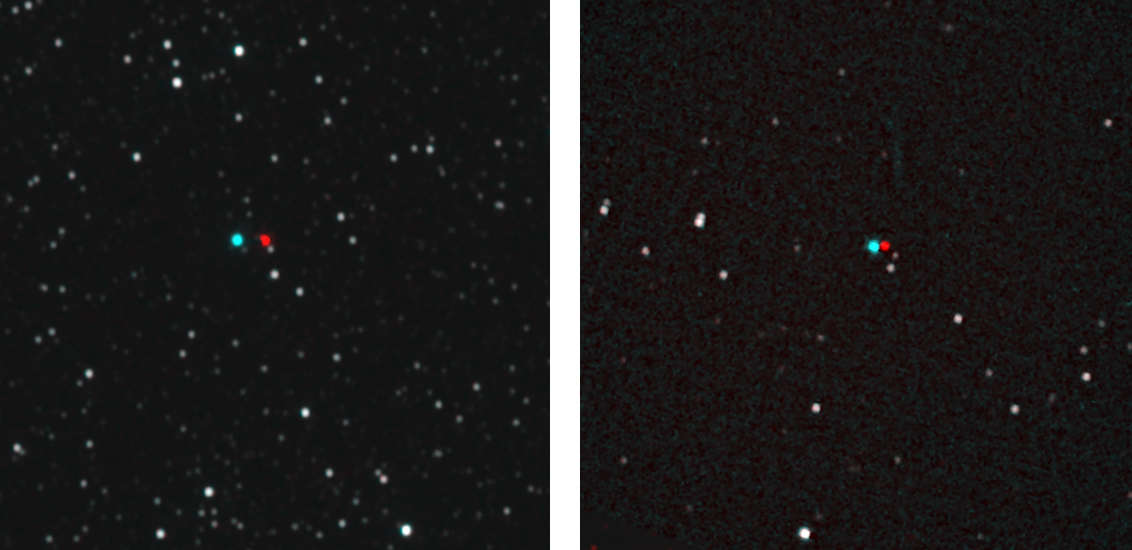Create a free profile to get unlimited access to exclusive videos, sweepstakes, and more!
New Horizons probe delivers first-ever parallax images of interstellar space

Offering a view slightly askew of what we Earthlings normally see as we gaze up into the heavens, NASA's distant New Horizons probe has just returned images of our galaxy featuring the stars Proxima Centauri and Wolf 359 aligned in the sky differently than what telescopes see from our home planet.
For the first time, a spacecraft has sent back "parallax view" pictures of the sky from so far away that some stars appear to be in different positions than we'd spy from our backyards. This marks an historic occasion where a spacecraft has traveled so far from our solar system that it snapped shots of repositioned stars no Earth-based person has ever observed.
Famous for its intimate photos of the dwarf planet Pluto and its five moons, New Horizons left the safe borders of our planetary grouping in late 2015. Now NASA's intrepid explorer is more than four billion miles from home and zooming out into interstellar space, where it has witnessed unique, unseen sights.
“It’s fair to say that New Horizons is looking at an alien sky, unlike what we see from Earth,” explained Alan Stern, New Horizons' main investigator from Southwest Research Institute (SwRI) in Boulder, Colorado. “And that has allowed us to do something that had never been accomplished before — to see the nearest stars visibly displaced on the sky from the positions we see them on Earth. No human eye can detect these shifts.”
New Horizons first launched back in 2006 and became the first mission to Pluto, the Kuiper Belt, and beyond. Investigating Pluto and its tiny satellites during the summer of 2015 in a series of close fly-bys, the spacecraft extended its odyssey beyond Neptune's orbit with a rendezvous with the rocky, ice-crusted Kuiper Belt object Arrokoth in January of 2019.
The New Horizons probe is expected to leave the territory outside of our solar system sometime around the year 2040, even though it will have stopped functioning years earlier, joining Voyager 1 and Voyager 2 as the most distant human-made machines from Earth.
By pairing New Horizons' remarkable images with similar shots of Proxima Centauri and Wolf 359 snapped on the exact same dates by remote telescopes at Siding Spring Observatory in Australia and Mt. Lemmon Observatory in Arizona, this parallax shift can be readily seen and offers a dream-like 3D impression of the stellar pair amid their starfield backdrop.
The anaglyph pictures below can be viewed using a pair of red-blue stereo glasses to reveal the stars' distance from their backgrounds.
To obtain these realigned images, New Horizons activated its long-range telescopic camera on April 22-23 and aimed the lens at the closest stars, Proxima Centauri and Wolf 359. This allowed for scientists to see the different places they occupy when compared to their set locations from Earth. The “parallax effect” of a star's sidestep against its background is useful to astronomers when attempting to measure distances to stars.
Parallax shifts are minute and barely recognized as the Earth orbits the sun, but at an extreme distance of billions of miles away, the effect is easily noticed by creating stereoscopic images.
“The New Horizons experiment provides the largest parallax baseline ever made — over 4 billion miles — and is the first demonstration of an easily observable stellar parallax,” said Tod Lauer, New Horizons science team member from the National Science Foundation's National Optical-Infrared Astronomy Research Laboratory.
Lauer, collaborating with New Horizons Deputy Project Scientist John Spencer and legendary Queen guitarist Brian May, who also just happens to be an acclaimed astrophysicist, created the stereoscopic examples that demonstrate the effect of the incredible distance between Earth and these two neighboring stars.
“It could be argued that in astro-stereoscopy — 3D images of astronomical objects — NASA’s New Horizons team already leads the field, having delivered astounding stereoscopic images of both Pluto and the remote Kuiper Belt object Arrokoth,” May noted in an official statement. “But the latest New Horizons stereoscopic experiment breaks all records. These photographs of Proxima Centauri and Wolf 359 — stars that are well-known to amateur astronomers and science fiction aficionados alike — employ the largest distance between viewpoints ever achieved in 180 years of stereoscopy!”





























